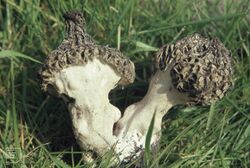Biology:Morchella vulgaris
| Morchella vulgaris | |
|---|---|

| |
| Scientific classification | |
| Domain: | Eukaryota |
| Kingdom: | Fungi |
| Division: | Ascomycota |
| Class: | Pezizomycetes |
| Order: | Pezizales |
| Family: | Morchellaceae |
| Genus: | Morchella |
| Species: | M. vulgaris
|
| Binomial name | |
| Morchella vulgaris (Pers.) Gray (1821)
| |
Morchella vulgaris is a widespread fungus of the family Morchellaceae (Ascomycota). It was originally described in 1801 as a form of the common yellow morel (Morchella esculenta) by mycologist Christiaan Hendrik Persoon, but was later recombined as a distinct species by Samuel Gray.[1]
Owing to its high morphological plasticity, its taxonomical status had long been in flux, sometimes treated as a variety of, or conspecific to Morchella esculenta,[2][3] while at the same time several forms and varieties of M. vulgaris itself have been described.[4] An extensive phylogenetic and nomenclatural study by Richard and colleagues in 2014, confirmed the status of Morchella vulgaris as a distinct species, and resolved several of its synonymities.[5]
This species is characterised by the predominantly grey colours of its cap and "blistered", highly irregular appearance of its ridges and pits.
References
- ↑ Gray SF. (1821). A Natural Arrangement of British Plants, according to their relations to each other Vol. 1. p. 662.
- ↑ Breitenbach J, Kränzlin F. (1984). Fungi of Switzerland, Volume 1: Ascomycetes. Verlag Mykologia, Luzern, Switzerland. p. 314.
- ↑ Dennis RWG. (1978). Bristish Ascomycètes. Ed. Cramer, Vaduz. p. 585.
- ↑ Clowez P. (2012). "Les morilles. Une nouvelle approche mondiale du genre Morchella" (in French). Bulletin de la Société Mycologique de France 126 (3–4): 199–376 (see p. 238).
- ↑ Richard, Franck; Bellanger, Jean-Michel; Clowez, Philippe; Courtecuisse, Regis; Hansen, Karen; O'Donnell, Kerry; Sauve, Mathieu; Urban, Alexander et al. (30 December 2014). "True morels (Morchella, Pezizales) of Europe and North America: evolutionary relationships inferred from multilocus data and a unified taxonomy". Mycologia 107 (2): 359–382. doi:10.3852/14-166. 14-166. PMID 25550303. http://www.mycologia.org/content/early/2014/12/24/14-166.abstract.
External links
Wikidata ☰ Q3323825 entry
 |


